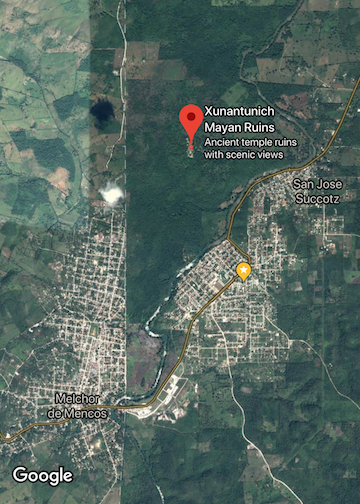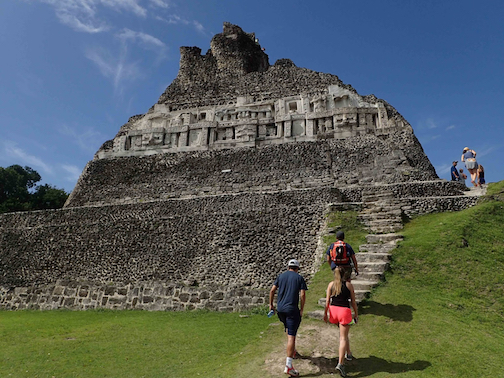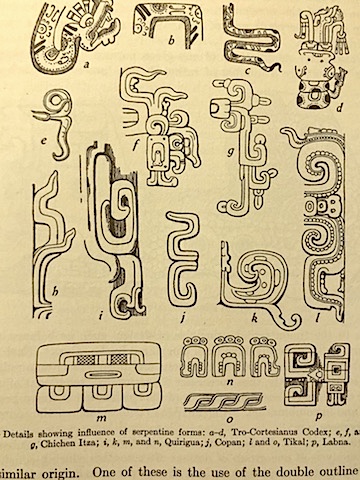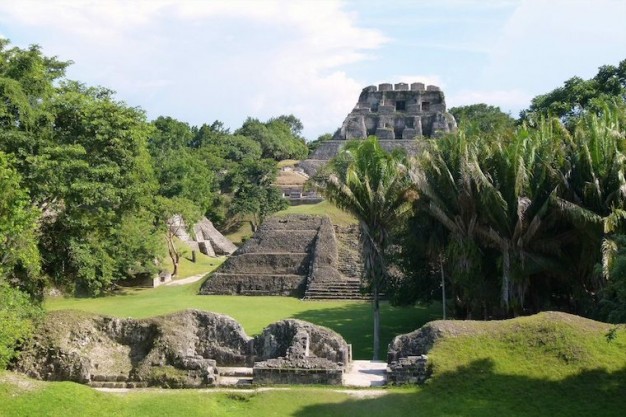Curating Xunantunich: Maya Ethnohistory & Iconography at the APS's Library
Header image: The site core at Xunantunich: Looking south towards El Castillo (Structure A-6) from the summit of Structure A-11.
Xunantunich is the oldest archaeological reserve and protected area in Belize. As a participant in the Xunantunich Archaeology and Conservation Project (XAC) during each month of July between 2016 and 2019, I was immersed in cultural heritage preservation activities at the site. Previous curatorial experience and graduate work in cultural heritage and preservation studies fueled interests beyond the archaeology at the site. I wanted to learn about the local techniques used to stabilize, consolidate, and in some cases modify the ancient monumental architecture in order to transform the site into a national park and popular destination for international tourists. My experience at this site and the surrounding communities informs my current interdisciplinary dissertation titled Curating Xunantunich.
Curating Xunantunich recognizes that the preservation of ancient Maya monumental stone architecture at the site has been achieved in great measure thanks to the collective agency and expertise of local Indigenous archaeologists and masons. A good number of these individuals are members of descendant Maya-mestizo communities that came to the area as refugees from the Caste War. As vernacular curators, their work has contributed to the scientific exploration, interpretation, and conservation of the site for future generations. By taking into consideration their contributions and perspectives as Indigenous community stakeholders, Curating Xunantunich frames archaeological conservation within a cultural landscape approach to the preservation of cultural and natural heritage.
Maya archaeology has always been related to the promise of economic development in Belize. Tourism has played an essential role as one of the drivers of the local and regional economy. As the most visited archaeological site in the years leading up to the COVID-19 pandemic, Xunantunich has played a significant role in branding campaigns for a competitive sector that looks towards a future where sustainable and ecologically sound tourism becomes the norm. Because of encroaching rural and urban development around the area in combination with massive deforestation on the other side of the Western frontier with Guatemala, the archaeological reserve has become an ecological sanctuary for regional flora and fauna.

By adopting a cultural landscape approach involving community stakeholders, a viable curatorial goal could lead to the modification of the existing architectural conservation paradigm that has operated at the archaeological reserve as a government-managed protected area through the integration of sustainable cultural and natural heritage preservation strategies at the site.

As one of two 2021-2022 APS Andrew W. Mellon Foundation Native American Scholars Initiative (NASI) Predoctoral Fellows, I would like to express my gratitude for the fellowship residency in extension of the 2020 Short-Term Research Library Fellowship that I completed last summer. At a time when most research archives remained closed to the public, the 2020 short-term research fellowship provided a once-in-a-lifetime research ‘lifeline’ when I needed it most.
Curating Xunantunich is based on field research in Belize, Guatemala, and Mexico, in combination with archival research at the American Philosophical Society, the Penn Museum Archives, Dumbarton Oaks, The Getty Conservation Institute, and The Library Company of Philadelphia. My dissertation combines the formal and iconographic study of Classic Maya art and monumental architecture with curatorial approaches to the integration of cultural and natural preservation at Xunantunich. In addition to the APS, fieldwork and archival research have been generously supported by Rutgers University, Dumbarton Oaks, Penn Museum, The Getty Conservation Institute, and US/ICOMOS.
During my time at the APS I have located and will continue to examine sources related to the following areas:
- The iconography of Maya art and architecture.
- The history of Maya archaeology in a critical context.
- The ethnohistory and ethnography of modern Maya groups.
- The colonial history of Belize as the Crown Settlement of British Honduras.
- The natural history of Belize in context with Central America and the Caribbean.

Among my favorite findings in the APS collections, I should highlight the early chronicles and ethnohistories of the lifeways of Maya groups going back to the 16th century. I also found exquisitely illustrated 18th-century publications, including some of the earliest studies of Maya art and architecture published in Europe. After the extraordinary experience of working in the research Library back in 2020, those are the two areas of inquiry that I plan to continue exploring throughout the APS Mellon NASI Predoctoral Fellowship residency.


